The global vegan footwear market is estimated to be valued at USD 34.45 Bn in 2025 and is expected to reach USD 58.31 Bn by 2032, growing at a compound annual growth rate (CAGR) of 7.8% from 2025 to 2032.
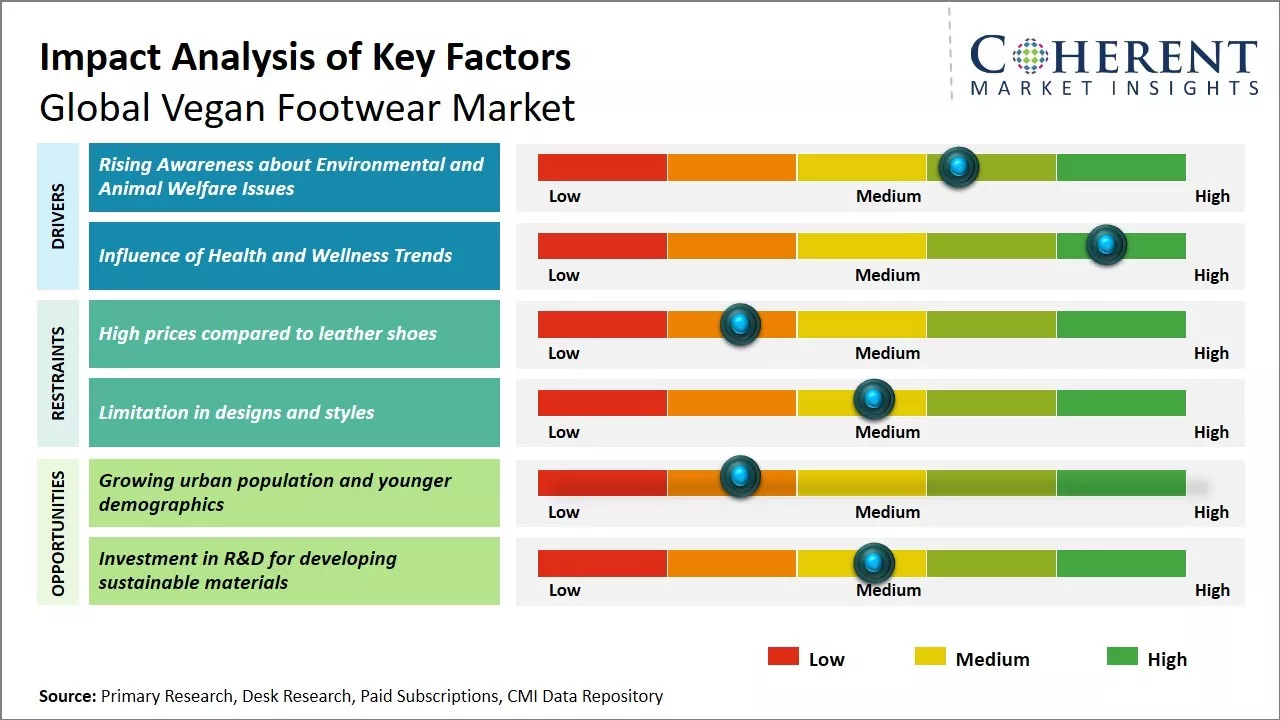
Discover market dynamics shaping the industry: Request sample copy
The vegan footwear market is experiencing positive growth trends driven by rising ethical concerns and health awareness among consumers. Many footwear brands have launched new product lines using innovative plant-based and recycled materials to cater to the growing demand. Moreover, favorable regulations and substantial investments in research and development of sustainable materials will further aid in market expansion. Increased social media marketing by leading brands is also effectively raising awareness about the benefits of vegan footwear.
Rising Awareness about Environmental and Animal Welfare Issues
The growing awareness about issues like environmental degradation, climate change, and animal welfare have prompted many consumers to adopt a vegan lifestyle. Mass production of leather involves considerable pollution as it requires large amounts of chemicals like dyes, solvents, and fertilizers. The tanning process also releases toxic substances into the air, soil, and water bodies. At the same time, the leather industry is criticized by animal rights activists for cruel practices like branding, dehorning, and separation of calves from mothers. More and more people are realizing how their everyday choices and consumption patterns impact the planet and other species. By opting for vegan footwear made from natural and man-made materials, consumers feel they are doing their bit in reducing harm. Plant-based footwear options allow customers to integrate their ethics of compassion with practical fashion choices. The vegan lifestyle is gaining appeal as an eco-friendly and conscientious way of living, driving interest in associated product categories like clothing and footwear.
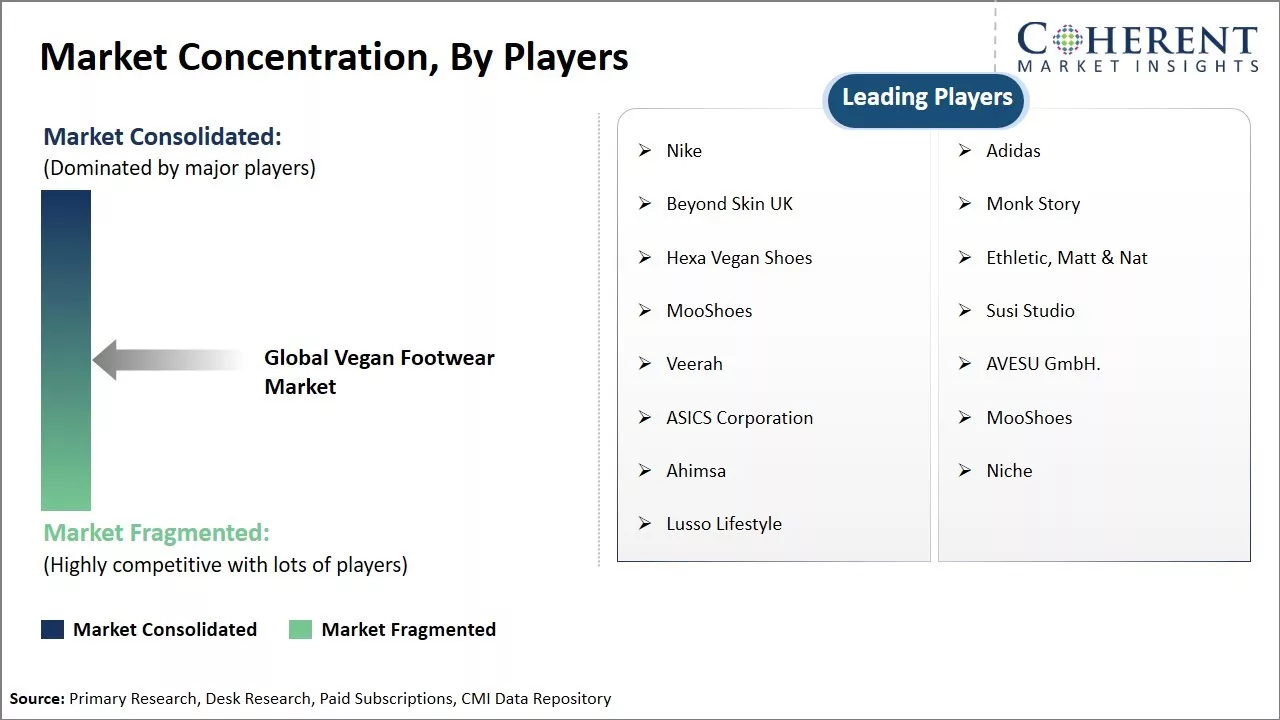
Get actionable strategies to beat competition: Request sample copy
Influence of Health and Wellness TrendsTraditional footwear materials like leather can potentially contain harmful chemicals which some people may want to avoid. At the same time, health and wellness has become a guiding principle for many lifestyle choices. Customers are increasingly health-conscious and prefer products believed to have wellness-boosting properties. Certain plant-based materials used in vegan footwear like natural rubber and wool are considered breathable and help keep feet cool and dry. Some plant extracts and natural dyes are touted as having antimicrobial qualities. Vegan alternatives to leather are often marketed as inherently “purity” focused and free of potential allergens. Growing mindfulness about toxic chemical exposure and importance of clean, toxin-free living is influencing preferences. Flexitarians and health advocates opt for vegan footwear believing it aligns better with their philosophy of overall well-being and protection from potentially harmful inputs. Experience of veganism as part of a holistic healthy lifestyle pushes the appeal of associated product categories in the green direction.
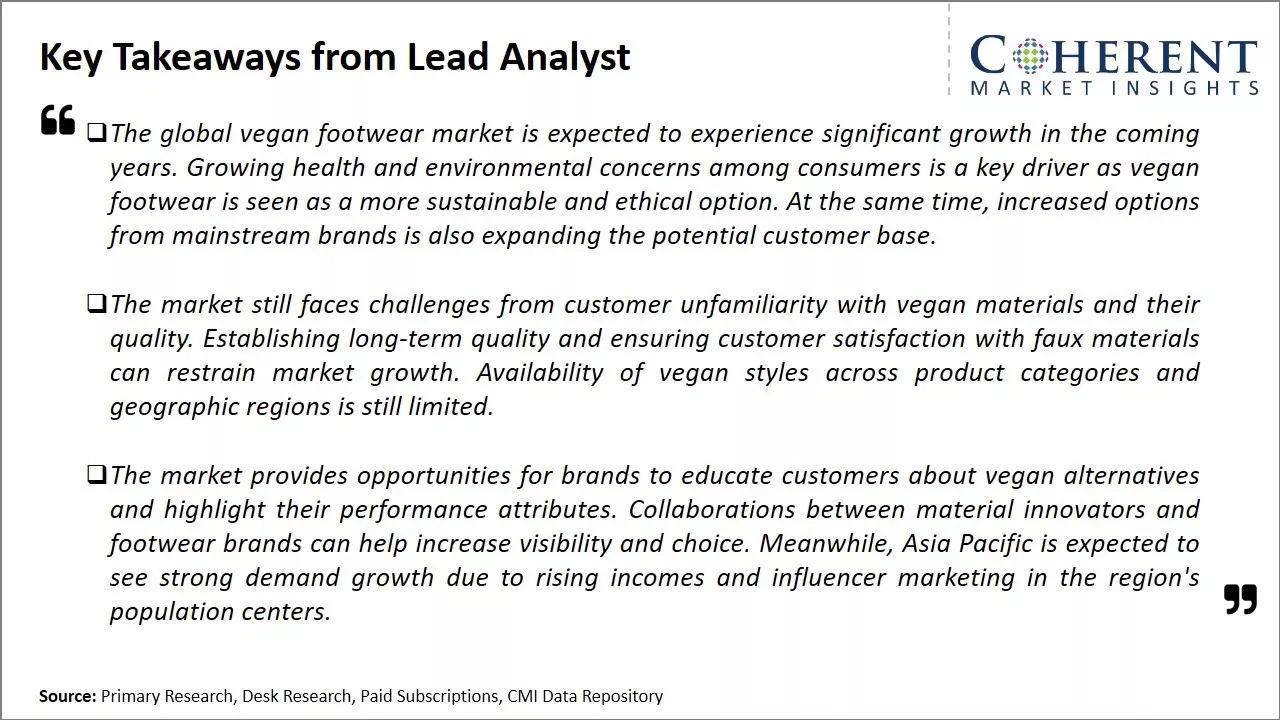
To learn more about this report, Request sample copy
Challenges: High prices compared to leather shoesHigh prices compared to leather shoes are significantly restraining the growth of the global vegan footwear market. Vegan footwear uses alternative materials like synthetic and plant-based fabrics for uppers and soles instead of animal-derived leather, wool and other materials. While vegan fashion is increasing in popularity due to rising animal welfare and environmental concerns, vegan shoes still cost notably more than similar leather shoes. This price difference is one of the biggest challenges for the widespread acceptance of vegan footwear globally. The production processes and materials required for vegan shoes tend to be more expensive than traditional leather shoes. Alternative faux leathers and novel plant-based fabrics are still emerging technologies and do not benefit from the same economies of scale as leather production. This means vegan materials have higher per unit costs than leather. Additionally, vegan shoe brands have smaller production runs currently, limiting their purchasing power for materials. The combined effect is that comparable vegan sneakers or formal shoes on average cost 20-30% more than their leather counterparts. For many environmentally-conscious or ethnically vegan consumers, this price point makes switching to an entirely vegan wardrobe challenging.
Opportunities: Growing urban population and younger demographics
The growing urban population globally especially in developing countries of Asia and Africa presents a huge opportunity for the vegan footwear market. As more people migrate to cities for employment and livelihood opportunities, urban lifestyles become the new normal. With paucity of space in crowded cities, people are adopting minimalistic fashion including vegan footwear made of sustainable plant-based materials without animal byproducts. Youths form a major part of the rising urban populations in Asia and Africa as per United Nations Population Fund data. The number of people in the age group 15-24 years globally will be 1.3 billion by 2030. This young generation is increasingly health conscious and cares about environment and animal welfare. They wish to make more ethical choices in their purchases including preferring vegan footwear over leather. Several studies show youth today devote considerable time on social media where they get exposed to vegan lifestyle influences. This has boosted demand for stylish, climate-friendly vegan shoes among new generation consumers.
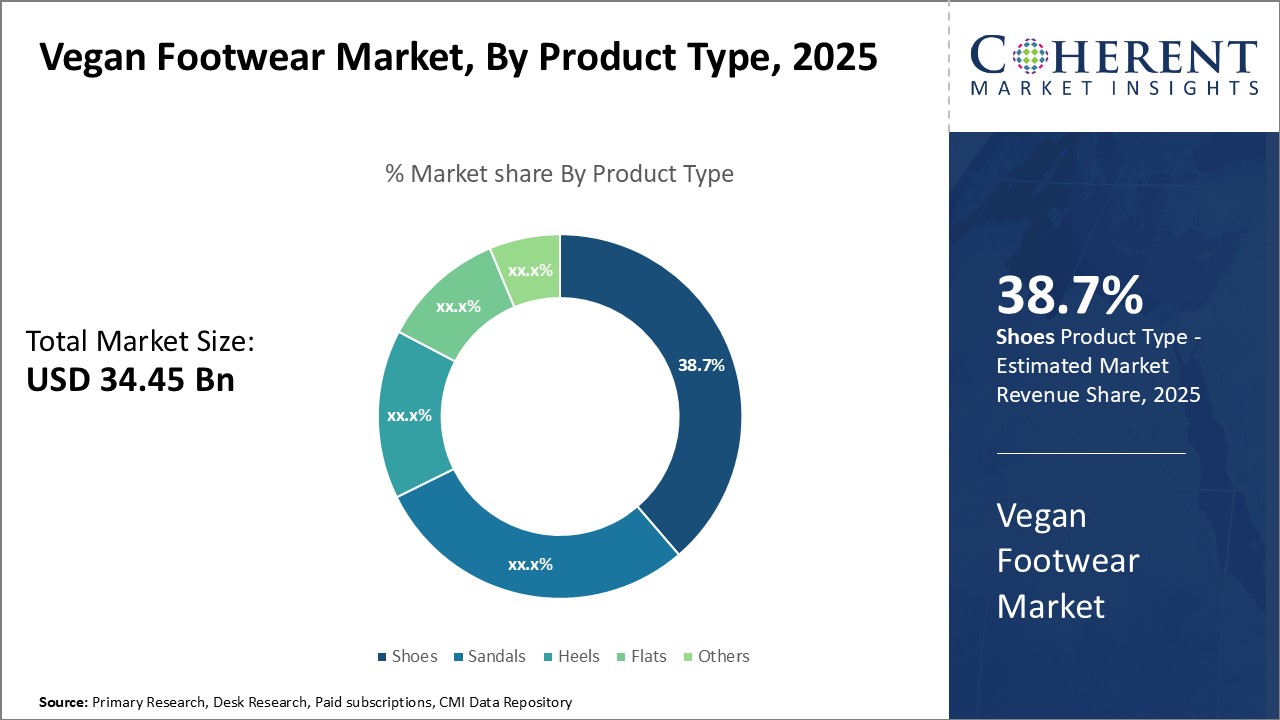
Discover high revenue pocket segments and roadmap to it: Request sample copy
Insights by Product Type: Comfort and Style Drive Shoe DominanceIn terms of product type, shoes is expected to contribute 38.7% share of the market owing to its comfort and versatile styling in 2025. Shoes provide cushioning and support for the entire foot, making them the most comfortable option for both casual and active lifestyles. They securely fit the foot and stabilize the ankle. Their versatile designs and silhouettes also allow shoes to be dressed up or down, making them a fashionable choice. Advancements in vegan materials have made shoes lightweight and breathable while replicating the look and feel of leather. The flexible nature of vegan shoe uppers contours nicely to the foot without breaking in. Their ease of use has made shoes the favorite product for urban populations and traveling.
Insights by Material Type: Durability Boosts Polyurethane’s Popularity
When it comes to material type, polyurethane is expected to contribute 35.8% of the market share due to its strength and longevity in 2025. Polyurethane closely mimics the performance of leather but without the drawbacks of animal agriculture. It is highly durable and resistant to abrasions, tears and water. Polyurethane vegan footwear maintains its structure and shape wash after wash. Its dense molecular composition prevents water seepage, keeping feet dry. The material's flexibility allows natural foot movement without breakdown. These durability advantages reduce the need to frequently replace vegan footwear made from polyurethane. It is thus a reliable and affordable option for frequent wear.
Insights by End User: Self Expression Drives Women's Participation
In terms of end user, women is expected to contribute 41.8% of the market share because footwear allows creative self-expression in 2025. Women experience vegan footwear as an accessory that completes an outfit and displays style and personality. Vegan brands offer an expanding palette of colors, textures, silhouettes, and designs catering to diverse fashion senses. Social media further popularizes trends that women enjoy following. Vegan materials have advanced to feel luxurious like genuine leather at affordable prices. Women recognize that animal-free options spare cruelty while making a statement. The movement toward ethical and sustainability-driven purchases also attracts female participants.
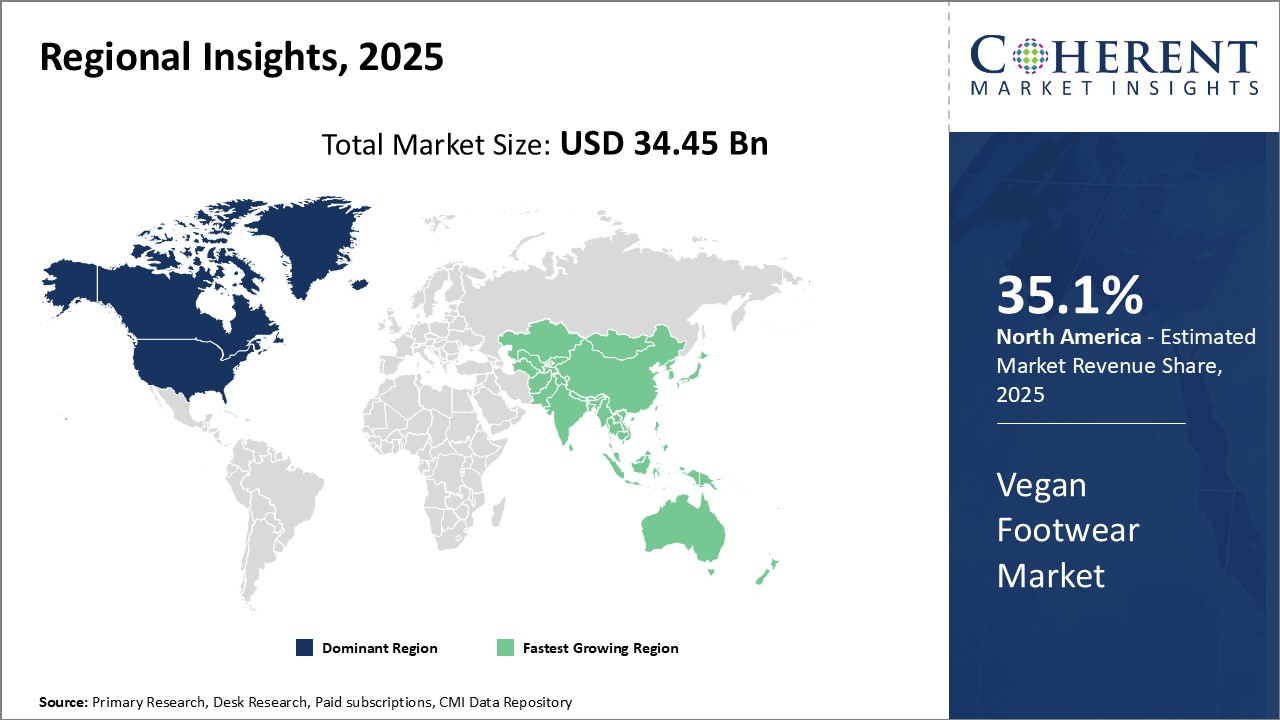
Need a Different Region or Segment? Customize now
North America has established itself as the dominant region in the global vegan footwear market. The region is expected to account for 35.1% of the market share in 2025. The U.S., in particular, is home to some of the largest mainstream footwear brands that offer extensive vegan collections such as Nike, Adidas, Allbirds, and Veja. Popular celebrity endorsements and the normalization of vegan and plant-based lifestyles have pushed vegan footwear into the mainstream. Retailers like Zappos and Revolve now make vegan footwear highly visible and accommodate growing demand. Further, established footwear trade shows like Stadium Goods exclusively feature vegan brands, cementing the category's presence. The growing preference for sustainability and ethics in fashion has spurred interest in vegan alternatives. As North American consumers become more conscientious about their purchasing decisions, the vegan footwear market continues to attract industry heavyweights. Established brands leverage existing supply chains and distribution to efficiently scale vegan offerings. New footwear entrepreneurs also find success launching online in the digitally savvy North American market and gaining followings on social media. Overall, the wide availability and high visibility of vegan options in North America have propelled the region to become the largest and most developed vegan footwear market globally.
The Asia Pacific region, driven mainly by China and India, is emerging as the fastest growing market for vegan footwear. Despite only making up a small current market share, momentum is building in APAC powered by increasing health awareness, rising disposable incomes, and growth of social media and e-commerce. As the two most populated countries, China and India specifically offer enormous consumer bases that are becoming more receptive to avant-garde lifestyle trends such as veganism. Their large, young populations also lend to a potential for sustained long-term growth. Furthermore, China's stringent environmental policies promote sustainability which vegan footwear fulfills. As APAC's affluence rises and ethical fashion gains cultural currency, the region is poised to become a vegan footwear global leader in the future.
Vegan Footwear Market Report Coverage
| Report Coverage | Details | ||
|---|---|---|---|
| Base Year: | 2024 | Market Size in 2025: | USD 34.45 Bn |
| Historical Data for: | 2020 To 2024 | Forecast Period: | 2025 To 2032 |
| Forecast Period 2025 to 2032 CAGR: | 7.8% | 2032 Value Projection: | USD 58.31 Bn |
| Geographies covered: |
|
||
| Segments covered: |
|
||
| Companies covered: |
Nike, Adidas, Beyond Skin UK, Monk Story, Hexa Vegan Shoes, Ethletic, Matt & Nat, MooShoes, Susi Studio, Veerah, AVESU GmbH., ASICS Corporation, MooShoes, Ahimsa , Niche , and Lusso Lifestyle |
||
| Growth Drivers: |
|
||
| Restraints & Challenges: |
|
||
Uncover macros and micros vetted on 75+ parameters: Get instant access to report
*Definition: The global vegan footwear market caters to customers who prefer footwear made without the use of animal products like leather or suede. Vegan footwear uses synthetic and plant-based materials like cork, wood fiber, and recycled plastic and natural rubber instead of animal-derived products. It offers ethical and sustainable footwear options for those who follow a vegan or plant-based lifestyle. The market has been growing in recent years due to increasing awareness about animal welfare and environmental protection.
Share
Share
About Author
Yash Doshi is a Senior Management Consultant. He has 12+ years of experience in conducting research and handling consulting projects across verticals in APAC, EMEA, and the Americas.
He brings strong acumen in helping chemical companies navigate complex challenges and identify growth opportunities. He has deep expertise across the chemicals value chain, including commodity, specialty and fine chemicals, plastics and polymers, and petrochemicals. Yash is a sought-after speaker at industry conferences and contributes to various publications on topics related commodity, specialty and fine chemicals, plastics and polymers, and petrochemicals.
Missing comfort of reading report in your local language? Find your preferred language :
Transform your Strategy with Exclusive Trending Reports :
Frequently Asked Questions
Joining thousands of companies around the world committed to making the Excellent Business Solutions.
View All Our Clients
US Reciprocal Tax Impact Analysis On Vegan Footwear Market
Stay updated on tariff changes with expert insights and timely information